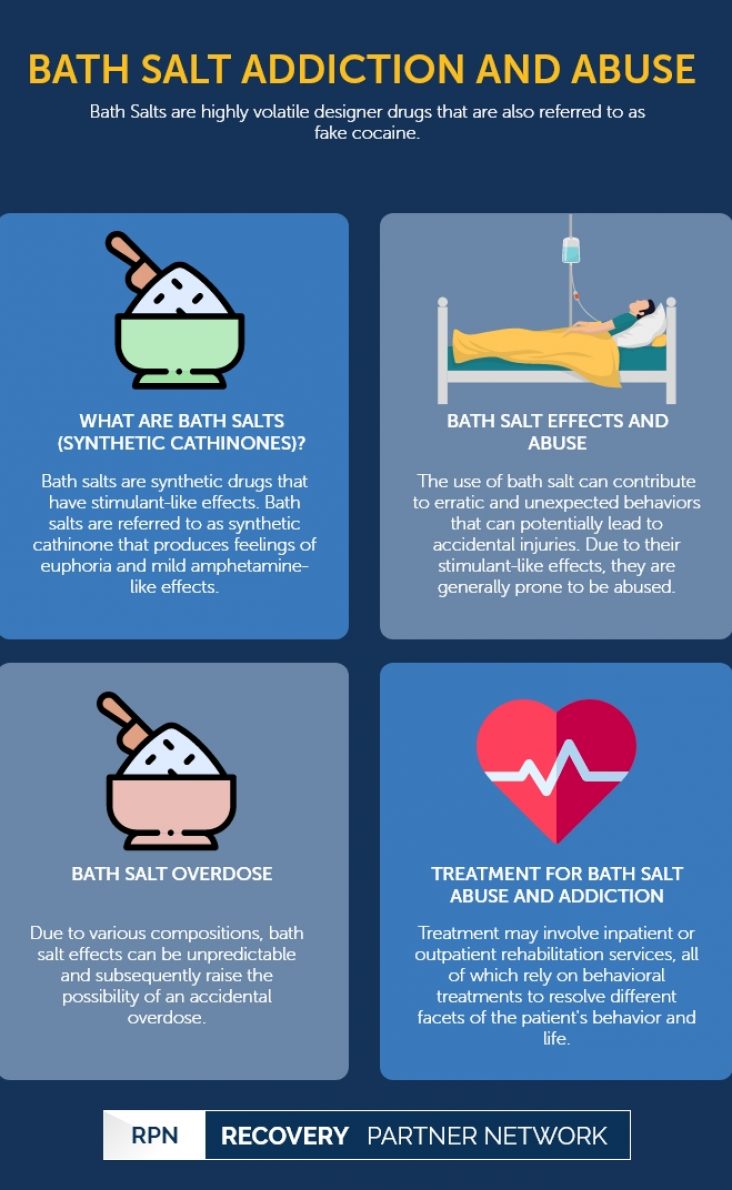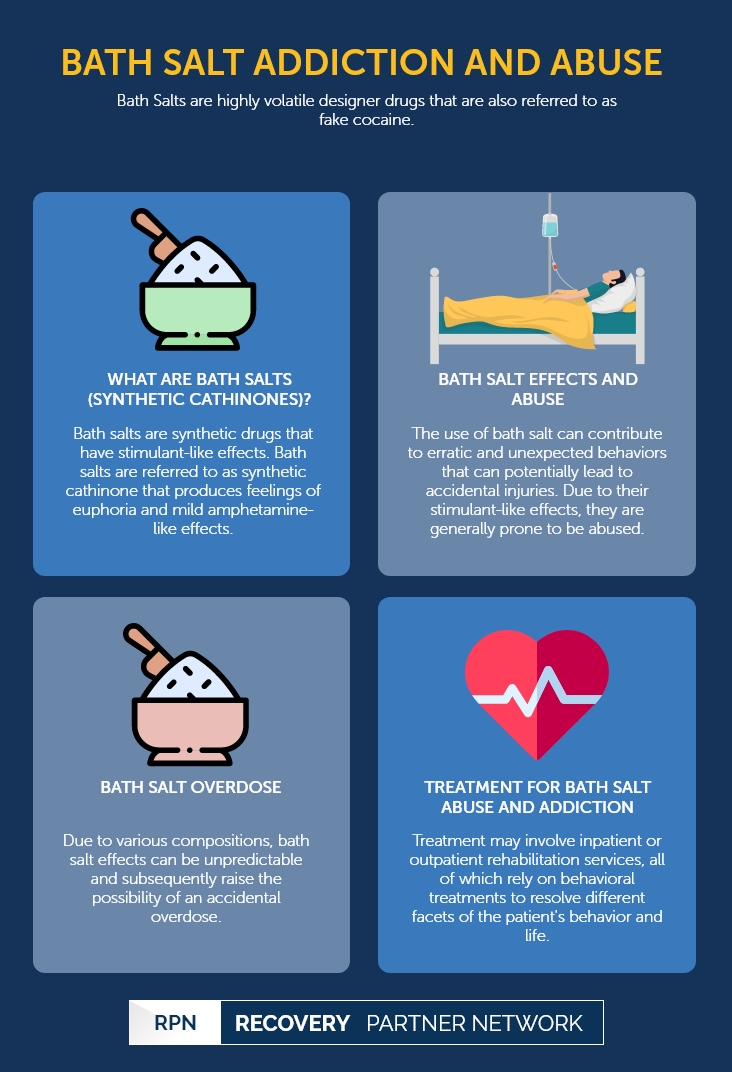Bath Salts are highly volatile designer drugs that are also referred to as fake cocaine.
Bath Salt Addiction and Abuse
Bath salts | Table of Contents
What Are Bath Salts (Synthetic Cathinones)?
Bath salts are a class of synthetic drugs that have stimulant-like effects. The term “bath salts” doesn’t just apply to a specific drug but rather a group of drugs with a similar chemical structure. Bath salts are also referred to as synthetic cathinones due to their similarity to natural cathinones, which is derived from the khat plant. The khat plant is native to East Africa and southern parts of the Middle East. When its leaves are chewed, it produces feelings of euphoria and mild amphetamine-like effects.
Synthetic cathinones (bath salts) have no connection to Epsom salts, which is generally used to relax and calm muscles. Instead, this drug derives its name from its appearance, which is a white or brown crystalline rock or powder. This drug is generally snorted, swallowed, smoked, or injected.
Some street names for bath salts are:
- Bloom
- Spice
- K2
- Cloud Nine
- Vanilla Sky
- Ivory Wave
- White Lightning
- Lunar Wave
- Scarface
- Flakka
Many of the chemicals used in the production of this drug are considered illegal. Some of the substances are Schedule I substances (such as 3,4-methylenedioxypyrovalerone). However, drug manufacturers often ignore regulations and sell bath salts in smoke shops and gas stations by creating minor changes to the chemical formulas or by labeling their products as “Not for Human Consumption.”
FAQ
Bath salts are recreational designer drugs, also known as synthetic cathinones. Bath salts are a class of drugs consisting of one or more synthetic chemical compounds similar to cathinones, which is a natural stimulant.
Bath salts are typically swallowed, snorted, inhaled, or injected.
Yes, bath salts are extremely addictive.
Bath Salt Effects and Abuse
Bath salts belong to a group of drugs called stimulants, as well as a class of drugs known as the “new psychoactive substances” (NPS). Since Bath salts include multiple chemical combinations, little research has been carried out on the physical and mental effects caused by this drug use. Bath salts share a chemical similarity with cocaine, amphetamines, and MDMA (Ecstasy). In fact, some bath salts are also known to have a close similarity to hallucinogens, like Ecstasy. As a consequence, the usage of bath salt can contribute to erratic and unexpected behaviors. One study has found that bath salts can be at least ten times more powerful than cocaine,
These drugs can cause:
- Clouded thinking
- Dizziness
- Euphoria
- Increased heart rate
- Intense nausea
- Intoxication
- Reduced motor control
- Sweating
- Vomiting
For some individuals, the mental impact of bath salts can be more severe due to the drugs’ potential to cause accidental injuries.
Some of these impacts include:
- Agitation
- Excited delirium
- Hallucinations
- Increased sociability
- Increased sex drive
- Panic attacks
- Paranoia
- Suicidal thoughts
- Violent behavior
Due to its similarity with common stimulants that are generally abused, such as cocaine or meth, bath salts are also prone to abuse. After Congress passed the Synthetic Drug Abuse Prevention Act in 2012, this drug was permanently classified as a Schedule I Substance under the Controlled Substance Act.
This drug rose to popularity in 2010 among teenagers and club-goers. Although bath salt abuse has declined since then, studies conducted in recent years have shown that less than 1% of teenagers have tried this drug in the past year. The decline of bath salt use could be attributed to the wide media coverage that reported on the disturbing and psychotic behaviors of individuals who were high on bath salts. These incidents involved violent and psychotic breaks, cannibalism, and various other adverse effects. Government crackdowns such as Operation Log Jam, which was initiated in 2012, also greatly helped in the decrease of bath salt use. This operation resulted in 109 cities being raided, 91 people being arrested, and 167,000 bags of bath salts being seized.
FAQ
- What are the effects of bath salts?
- Can you overdose or die from bath salts?
- Why are bath salts so dangerous?
The artificial cathinones in bath salts can momentarily produce feelings of joy, increased social interaction, and increased sex drive. However, they can also produce paranoia, nervousness, and hallucinations.
Yes, bath salts have been known to cause overdose and death among certain users. Most damage is caused by injecting bath salts, snorting, or mixing them with other substances such as alcohol.
Bath salts may contain other ingredients that cause harmful effects on their own. Unless tested in a lab, there is no way of knowing what’s in a dose of bath salts.
Recognizing Signs of Bath Salt Use
The use of bath salts can generate erratic and und unpredictable behaviors. Many of the signs of bath salt use are similar to that of cocaine use.
- Restlessness
- Hallucinations
- Anger or agitation
- Changes in mood
- Dilated pupils
- Delusions
- Presence of drug paraphernalia
- Neglecting responsibilities at home, school, or work
- Paranoia
- Violent behavior
- Financial problems
Bath Salt Addiction and Withdrawal
As a recent psychoactive drug, not much is known about bath salts’ addictive potential. However, there have been studies conducted on rats that show the animal self-administering synthetic cathinones during testing; this indicates a compulsion being formed to use the drug frequently. Consumption of these drugs leads to a natural response by the brain’s dopamine reward system responsible for developing addiction over time. Teens and young adults have a higher chance of abusing and becoming addicted to synthetic cathinones after frequent use.
Some individuals who have developed a dependency on bath salts had also started to experience the following withdrawal symptoms:
- Depression
- Anxiety
- Tremors
- Insomnia
- Paranoia
Bath Salt Overdose
Due to the variations of the composition, bath salts’ effects can be unpredictable, and thus raising the possibility of accidental overdose. There is really no way for users to determine the dose and purity of the drug, so the use of any quantity can lead to an overdose.
Signs of an overdose may include:
- Seizures
- Heart palpitations
- Difficulty breathing
- Psychosis including paranoia and hallucinations, and severe agitation
Treatment for Bath Salt Abuse and Addiction
Dependence on bath salt can be effectively treated with a comprehensive strategy. Treatment may involve inpatient or outpatient rehabilitation services, all of which rely on behavioral treatment to resolve different facets of the patient’s behavior and life.
These treatment programs also use cognitive behavioral therapy that can be conducted through individual sessions, group counseling, or both. Various forms of support can often be beneficial, including support groups and peer monitoring. Although, there are no officially accepted medications to cure addiction to bath salts. Certain medications like antidepressants are generally used to treat symptoms of co-occurring depression and anxiety.
Recovery Partner Network
We aim to educate and empower. If you feel our library of resources does not cover your specific need, reach out to us, and we would be happy to help.
STATISTICS
© Copyright 2025


